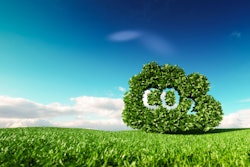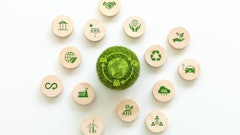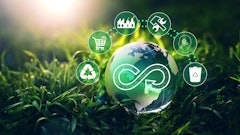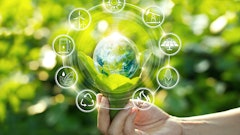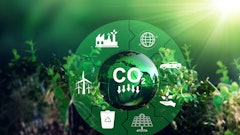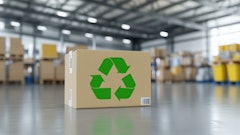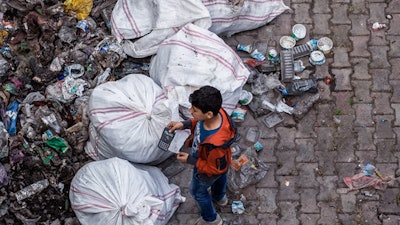
It might be dismaying, if not shocking, to learn that humanity’s demand for natural resources far exceeds what the planet is capable of regenerating. Americans currently consume the equivalent of around 1.7 earths every year. With global demand increasing, it is expected by 2050 that we will need the equivalent of 3 earths. Current resource consumption rates are obviously unsustainable, and if we continue on this current trajectory, we’ll inevitably deplete all of the planet’s resources.
As the global population continues to grow and the demand for goods increases in-kind, there’s mounting pressure on companies to produce more, and more quickly, in order to stay relevant. To meet this fevered demand, humanity has relied on linear “take‑make‑waste” supply chains and disposable-economy models. Products get thrown away and become landfill. Yet more are produced to meet an ever-growing need.
Electronic equipment waste, in particular, represents one of the most glaring threats to the planet’s long-term stability. The United Nations estimates that the current 53 million tons of e-waste generated every year will double by 2050, making it the world’s fastest-growing waste stream. Likewise, global plastics production currently totals over 360 million metric tons per year. Nearly 50% of those are single-use plastics--they’re produced, used once and thrown away. The cumulative total of plastics produced is now over 8 billion tons worldwide, with around 10 million of those tons ending up in oceans each year.
It’s time for the disposable “take-make-waste” economy that humanity created to change. To slow down the wanton consumption of earth’s natural resources, stop plastic pollution and raw materials waste, we need a circular economy that works for everyone. The good news is, steps are being taken toward just such a model.
Slowing down the natural resource consumption rate
Manufacturers need to reduce the consumption of natural resources by recycling raw materials from end-of-use products and reconditioning or repurposing their components for use in new products. By using digital and Internet of Things (IoT) technology, for example, manufacturers can empower consumers and employees to monitor the usage, performance and overall integrity of factory or household equipment. Sensor technology can help predict problems and equipment failures, facilitate proactive maintenance and ensure equipment remains viable at critical junctures. Products will need to be designed with both end-of-use and remanufacture in mind. This requires designing in-processes for disassembly to reclaim raw materials and components that can be reconditioned, reused or remanufactured.
When products are no longer viable, artificial intelligence (AI) and robotics technology can salvage useful remnants from those products. By using digital technology, manufacturers can assess returned products and materials for refurbishment, re-manufacture or resale at a relatively low cost, and by keeping the same materials in circulation longer, they’ll constrain the rate of natural resource consumption.
Click here to hear to more about the circular economy:
Recovering end-of-use products for remanufacture
Manufacturers need to increase the probability of recovering end-of-use products in order to reuse components or reclaim raw materials for new products. To that end, they can offer direct-to-consumer, subscription-based “product-as-a-service” mechanisms that use sensor technology to monitor product consumption and usage up until end-of-use. The manufacturer can then provide the consumer with an automated direct replacement of the product while collecting any vessels, cartridges or containers for reincorporation in the manufacturing process. In this scenario, the manufacturer’s reduced consumption dovetails with them gaining better insight into the consumer's product experience by understanding the frequency of use in demand/replacement cycles.
Removing intermediaries in the supply chain can also provide greater value to the customer. Getting rid of the middleman costs less and ensures new products arrive directly at your door when you need them.
Industrial symbiosis
Industrial symbiosis is the process by which waste or byproducts from one company or industry become the raw materials for another. The waste or byproduct can either be donated or sold to another company allowing the resources to then be monetized and reused. Moving materials and resources between different companies and industries is key not just to creating a circular economy, but also to ensure the best possible use of natural resources.
Leveraging technology and making circular economies happen
All of the above scenarios can reduce natural resource consumption, increase raw material productivity and lifecycles and reduce manufacturing costs. Whether it's via extending the life of mechanical and electronic appliances through remote performance monitoring, providing products direct-to-consumer with a system for reclaiming unwanted containers and cartridges or improving the speed of disassembly and raw material reclamation for re-use, digital technology plays a pivotal role in making that reality.
The provenance and flow of components, products and materials through supply chains to their end-of-use needs to be transparent. Unique identifier technologies such as cryptographic anchors, molecular DNA tags or RFID tags can be applied to the surface of a component or product or embedded into raw materials to gather data on how wasteful a given supply chain is. Using these unique identifiers in conjunction with blockchain not only authenticates the provenance and origin of components and materials, but it also provides location-based information for tracking and tracing product conditions.
Leading organizations are now focusing their efforts on using technologies to enable the transition to a circular economic model. Technologies such as IoT, predictive and prescriptive analytics, 3D printing, AI and machine learning, blockchain and digital twins all have an essential role to play in this transition.
Products-as-a-service
To further encourage the paradigm shift toward a circular economy necessitates a change in how we think about product acquisition. The motor industry offers drivers the opportunity to lease their cars with the option to buy after some certain period of time has passed. This product-as-a-service (PaaS) leasing model is now being adopted by other manufacturers. Instead of purchasing a washing machine, you can lease one. A consumer can enter into a contract with the manufacturer based on an agreed number of individual washing cycles or time and be billed monthly. At the end of the contract, the manufacturer collects the machine and replaces it with a new one and a new leasing contract, or just takes the machine away for the consumer to consider other competitive leasing options. Either way, the machine is back in the hands of the manufacturer, who can now refurbish the machine for reuse.
During the consumer’s use of the machine, the manufacturer can not only monitor its usage, but also its integrity. Using IoT sensors and predictive analytics, the manufacturer can keep an eye on the health of the machine and recommend that the user proactively replace a given component before it breaks.
There are many examples of where PaaS and leasing models are becoming more commonplace by using digital technology to enable provision, service and financial arrangements. This is just one area where industry is evolving to meet the moment, but an important one, and illustrates how radically manufacturers can rethink their business models, if they are so motivated. Moving to a more sustainable, less wasteful business model doesn’t have to mean a net loss for companies. If anything, the available examples seem to suggest that such transitions will open up unforeseen opportunities for new revenue streams and technological innovation. Far from being a zero-sum proposition, the conservation of raw materials and resources, it seems, can be of benefit to both consumers and manufacturers.






